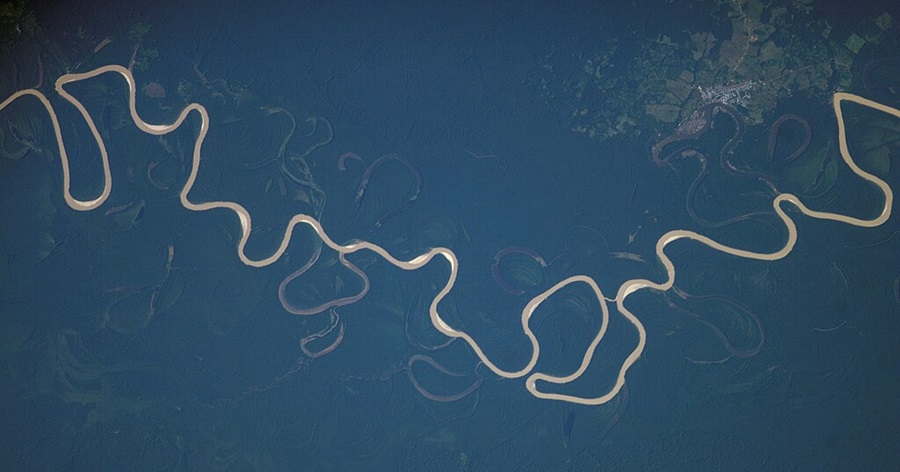

The Amazon River is the longest river in South America, stretching approximately 6,400 km. It traverses the heart of South America, originating in the Peruvian Andes and flowing eastward through Brazil before emptying into the Atlantic Ocean. This immense river system boasts a vast basin, covering over 7 million square kilometers and encompassing diverse ecosystems, from lush rainforests to wetlands. Its length and the sheer volume of water it carries make it a critical artery for the region, with countless species of flora and fauna reliant on it for sustenance and survival. The Amazon River is a vital natural wonder of global significance.

The Rio de la Plata-Paraná River is a major waterway in South America, formed by the confluence of the Paraná and Uruguay rivers. It extends for approximately 290 km from its junction with the Atlantic Ocean, running through Argentina and Uruguay. The Paraná River, one of its main tributaries, originates in Brazil and flows over 4,800 km before merging into the Rio de la Plata. This estuary serves as a crucial transportation route for the region, supporting commerce and trade. Its lengthy course and economic importance make the Rio de la Plata-Paraná River a vital lifeline for South America.

The Purús River, located in South America, is approximately 3380 km long. It flows primarily through the Amazon Rainforest in Peru and Brazil, making it one of the major tributaries of the Amazon River. This river is known for its remote and pristine wilderness, surrounded by dense tropical rainforests, and it provides vital aquatic habitats for a wide variety of wildlife.

Madeira-Mamoré River is a large river located in South America. It stretches around 3250 km in length. It originates from the Guaporé Massif, located in the Brazilian state of Mato Grosso, and flows to the northeast, crossing the Bolivian border and entering the Beni Department in Bolivia. The river then makes a sharp turn to the southwest and enters Brazil again, finally emptying into the Amazon River. Along its course, the Madeira-Mamoré River passes through several cities, including the Brazilian cities of Porto Velho, Ji-Paraná and Humaitá, and the Bolivian cities of Riberalta, Guayaramerín and Santa Ana de Yacuma.

The São Francisco River, known as the "Velho Chico" in Brazil, is a prominent river in South America, stretching approximately 2,914 km in length. Originating in the Brazilian state of Minas Gerais, it flows through five states, including Bahia and Pernambuco, before emptying into the Atlantic Ocean. This river is of significant historical, cultural, and economic importance to Brazil, as it has facilitated agriculture, transportation, and settlements in the arid northeastern region.

The Japurá River, also known as the Caquetá River in Colombia, is a vital waterway in South America. It spans approximately 2820 km in length, making it one of the longest tributaries of the Amazon River. Originating in the Colombian Andes, it flows through dense rainforests in Colombia and Brazil, eventually joining the Amazon.

The Paraguay River is a major river in South America with a total length of 2695 km. It originates in the highlands of the Brazilian state of Mato Grosso do Sul, and flows through Brazil, Bolivia, Paraguay, and Argentina before eventually emptying into the Rio de la Plata at the city of Buenos Aires in Argentina. The Paraguay River is the main river of the Paraguay basin, and it is the main source of water for the countries through which it flows. Its main tributaries are the Pilcomayo, Bermejo, and Apa Rivers.

The Tocantins-Araguaia River is a significant waterway in Brazil, with a total length of around 2640 km. It forms in the central Brazilian state of Goiás, flowing northward through the states of Tocantins and Pará before merging with the Amazon River system. This river plays a vital role in the region's hydrology, providing water resources and transportation. It's flanked by diverse ecosystems, including savannas, wetlands, and forests, supporting rich biodiversity. The Tocantins-Araguaia River has been harnessed for hydroelectric power and irrigation, contributing to regional development while posing environmental challenges. Its extensive course and multifaceted impact make it a prominent feature of Brazil's landscape.

The Juruá River is a significant waterway in South America, primarily flowing through Brazil and Peru. It spans approximately 2400 km in length. Originating in the Peruvian Andes, the river meanders through lush tropical rainforests, including the Amazon Basin, before joining the Amazon River. The Juruá River is characterized by its unique and pristine ecosystems, providing habitats for diverse wildlife, such as rare bird species and aquatic creatures.

The Orinoco River is a major river located in northern South America. It is 2250 km long. The Orinoco River originates in the Guiana Highlands in the south of Venezuela and then flows northeast. It passes through numerous tributaries as it winds its way to the Caribbean Sea near the city of Cumaná. The river also forms a natural boundary between the two countries. The Orinoco River is a major source of water for both Venezuela and Colombia. It is also an important waterway for transportation, with numerous barges and ships navigating the river.